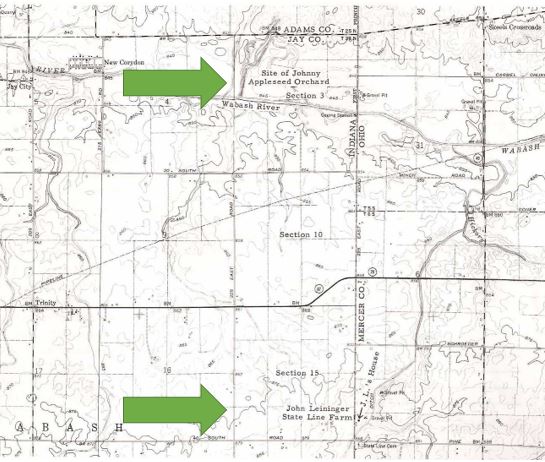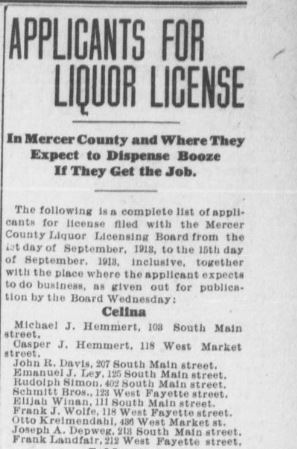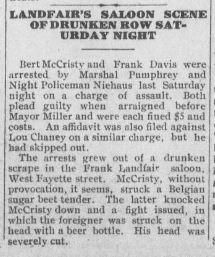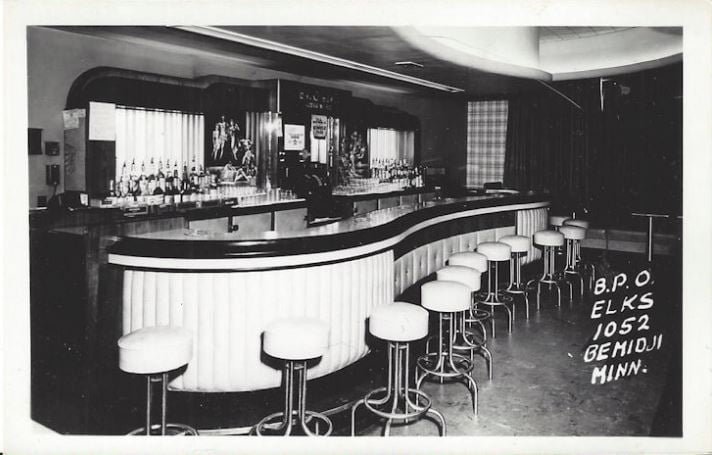‘Tis the season to eat, drink and be merry – yet it’s difficult to envision our strait-laced ancestors as engaging in celebrations involving alcohol. My dad’s side of the family were teetotalers (those who practice abstinence from alcohol) so I didn’t initially investigate records linking them with liquor in my family history research. That was a mistake!
When you think of taverns you might recall the 1980s television sitcom Cheers, the place “where everybody knows your name.” The neighborhood bar, however, is not a 20th century phenomenon. The English word tavern, derived from the Latin word, taberna, originally referred to a stall, shed or pub where wine could be purchased. Roman-established inns were primarily known for selling beer, along with food and lodging. Inns, becoming synonymous with taverns, have provided space for town meetings, court cases and entertainment for more than two millennia.
In the United States, the first tavern was founded by Samuel Cole in Boston, Massachusetts on 4 March 1633.[1] It seems unusual that our pious Puritan ancestors may have been kicking back with a pint, but “victualling” houses were considered so important that by 1656 the General Court of Massachusetts required that every town have one or be subject to a fine.[2]
Editor’s Note: It is important to note that taverns (or “ordinary” houses as they were also known in England and early American colonial days) generally only served beer, wine and hard cider (as well as food) and were often an important meeting place for the entire community. They can be distinguished from a modern bar that often focuses on selling only alcohol, including hard liquor. Lounges, pubs (public houses) and saloons are also common terms for various types of meeting, lodging and drinking establishments and, while there are some big differences in what these terms mean (depending on the location and time period you are in), the terms are sometimes used interchangeably. Wikipedia has an interesting breakdown here on the differences.
So, what does all this have to do with your family’s genealogy?
Through investigating spirits, the alcohol type, you might be surprised by what records can be uncovered.
My first discovery occurred while reading a family history book about my Leininger forefathers. John Chapman, aka Johnny Appleseed, is my 3rd great uncle through marriage. One of Johnny’s nieces, Elizabeth Broom, daughter of his sister, Persis Chapman Broom, resided with her husband, John George Leininger, near Johnny’s orchard in Jay County, Indiana:
As a child, Elizabeth’s father, William Broom, “assisted Chapman as an orchardist and would handle much of the business of selling seedlings…”.[4]
I was delighted to discover this connection but shocked as to the real reason that apples were so important to settlers; “they were used to make America’s beverage of choice at the time, hard apple cider.”[5] Perhaps my Leiningers didn’t imbibe but they certainly profited from others who did.
My next discovery furthered my knowledge of the importance of taverns in the good ole days. On a family vacation to explore my husband’s 3rd great grandfather, George Mitchell Long’s, life we stopped in Morristown, Tennessee where he was buried. We learned that David “Davy” Crockett’s father, John, built a tavern there and it was the childhood home of Davy.[6]
Besides hunting game for use in the tavern Davy took care “of the livestock of the cattle drovers and sheep herders who were staying at the tavern.”[7] One of George Long’s sons, John, recalled that George had said his first job at age 13 was as a cattle driver in Morristown.[8] George was born about 1787 and Davy in 1786. Although records no longer exist linking the two men, it is plausible that their path crossed, perhaps at that local tavern.
Tavern (as well as ordinary, inn, pub and saloon) records can be a very good source of genealogical information. You might discover petitions, bonds, licenses or renewal applications by searching local court records or the collections held by local historical and genealogical societies.
Shown here is an annual license renewal from Trumbull County, Ohio that can be found by browsing Common Pleas court records for that area on FamilySearch:
The State of New Jersey has a searchable database online for many, but not all, of their Taverns and Inns Licenses beginning as early as 1680 for Gloucester County.[10]
Chester County, Pennsylvania also offers tavern petitions from 1700-1923 online.
While there is no single repository for these valuable records, you can search in Google or look at the holdings of genealogical and historical societies in the state,, county or city your ancestors lived in for more of these collections. Here is a list of family history research sites for every U.S. state to get you started.
Approved liquor licenses may also be found in old newspapers:
The last licensee in the image above, Frank Landfair, happens to be my great grandfather. And what I went on to discover may explain why some of my family shunned alcohol.
Sometimes the connection to drink is not related to a tavern at all, however. My husband’s 11th great grandfather, Guillame de la Vigne married Adrienne Cuvellier about 1608 in Valenciennes, Nord, France. The young Walloon family fled the region’s instability first to the Netherlands and ultimately, to New Netherlands about 1614.[13]
In French, Cuvellier is a variant of faiseur de cuves, tonnielier, meaning a maker of casks.[15] De la Vigne can be translated as “of the vine.” Did the children of a barrel maker and a grape grower unite to solidify a business partnership? Although I’ve yet to establish that was the reason for the relationship, I found that their son, Jan, owned a brewery and lot on Maiden Lane, New Netherlands in the early 1660s.[16]
A final tip – fraternal organizations, like taverns, often provided (and still do) a social hall for use by members and can be valuable to your research. Contact the organizations still in existence as their historian may have photos or records of their past members. For defunct groups, check with the town’s library staff for the whereabouts of the lodge records.
I like to think of that old folk song, “There Is a Tavern in the Town” when I consider the wonderful underused resources related to liquor and taverns. I propose a toast to liquor-related records as they’ve helped me gain a better understanding of my ancestors’ lives. Perhaps they’ll help you, too.
She drank good ale, good punch and wine
And lived to the age of 99.
From the Edwalton Church graveyard, Nottinghamshire, Great Britain for Rebeca Freeland who died in 1741. [17]
Lori Samuelson is a lifelong educator, author and National Board Certified Teacher/Counselor who has conducted personal genealogical research for more than 30 years. Currently, she is working on her 2nd eBook, Thanks to the Yanks: Letters from an American Private Serving in World War I. Lori is married to her high school sweetheart and they are the proud parents of two adult children. Visit her website, GenealogyAtHeart.com for more research tips and heartwarming genealogical stories.
Article References
[1] Gavin Nathan, Historic Taverns of Boston: 370 Years of Tavern History in One Definitive Guide (NY: iUniverse, Inc., 2006); digital image, Google Books (https://books.google.com/: accessed 10 Nov 2017) 3.
Robert Charles Anderson, The Great Migration Begins 1620-1633, Vol 1, A-F, “Samuel Cole;” digital image, Ancestry.com (Ancestry.com: accessed 10 Nov 2017) 430.
[2] Alice Morse Earle, Stage-coach and Tavern Days (New York: Macmillan Company, 1900) 1; digital image, Archives.org (Archives.org: accessed 10 Nov 2017).
[3] Robert LeRoy Leininger, Leininger Family History and Genealogy “Two Centuries of Leiningers,” (Self Published: Manchester, IN, 1971), 7f.
[4] Ibid, 2f.
[5] Natasha Geiling, “The Real Johnny Appleseed Brought Apples-and Booze-to the American Frontier” Nov 2014; digital image, Smithsonian Magazine (https://www.smithsonianmag.com/: accessed 10 Nov 2017).
[6] History of the Hamblen County Chapter Association for the Preservation of Tennessee Antiquities (APTA), “Abbreviated History;” digital image, Crockett Tavern Museum (http://crocketttavernmuseum.org: accessed 12 Nov 2017.
[7] Ibid.
[8] Wilbie Long, Genealogy of the John A. and Elizabeth Troxell Long Family (Self Published: Connersville, IN, 1959) np.
[9] “Ohio, Trumbull County Records, 1795-2010;” digital images, FamilySearch (https://familysearch.org: accessed 24 October 2014), citing Common Pleas records, Common pleas journal, Vol. 7, May 1831-May 1833, image 4 of 437; Trumbull County Courthouse, Warren.
[10] “Taverns and Inns Licenses;” digital database, New Jersey State Archives (https://wwwnet-dos.state.nj.us/).
[11] The Celina [Ohio] Democrat, “Applicants for Liquor License” 19 Sep 1913, p. 1, col. 7; digital image, Library of Congress, (ChroniclingAmerica.loc.gov: accessed 12 Nov 2017).
[12] The Celina [Ohio] Democrat, “Landair’s Saloon Scene of Drunken Row Saturday Night” 12 Sep 1913, p. 1, col. 3; digital image, , Library of Congress, (ChroniclingAmerica.loc.gov: accessed 12 Nov 2017).
[13], Louis P. DeBoer, “Peter Minuit” New York Genealogical and Biographical Record, Vol. 59 (1928):60.
[14] Hartger, New Amsterdam. 1626. Engraving; digital image, East Tennessee State University (Faculty.etsu.edu: accessed 10 Nov 2017).
[15] Paul Chapuy, Origine des Noms Partonymiques Francais (Paris: Dorbon-Ainé, 1934) 48, 78, 148.
[16] John H. Innes, New Amsterdam and Its People (New York: Charles Scribner’s Sons, 1902) 306-307.
[17] Thomas Joseph Pettigrew, Chronicles of the Tombs: A Select Collection of Epitaphs (London: George Bell & Sons , 1888); digital image, Google Books (https://books.google.com/: accessed 1 Dec 2017) 507.
[18] Elaine Peterson, Bemidji, Minnesota Elks Club #1052 Photo, Circa 1940-1950’s, Item # BNT38pc (SOLD); digital image, Back N’ Time Antiques and Americana (Back-n-time-antiques.com: accessed 21 November 2017) 2.
You might also like:
This Newspaper Site Lets You Clip Directly to Your Ancestry Tree
How to Use Internet Archive for Genealogy Research






